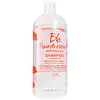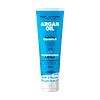What's inside
What's inside
 Key Ingredients
Key Ingredients

 Benefits
Benefits

 Concerns
Concerns

 Ingredients Side-by-side
Ingredients Side-by-side

Water
Skin ConditioningDisodium Laureth Sulfosuccinate
CleansingSodium Cocoyl Isethionate
CleansingSodium Lauryl Sulfoacetate
CleansingGlycerin
HumectantSodium Lauroyl Sarcosinate
CleansingCoco-Betaine
CleansingAcrylates Copolymer
Decyl Glucoside
CleansingButylene Glycol
HumectantLaureth-23
CleansingGlycol Distearate
EmollientGlycereth-26
HumectantVitis Vinifera Seed Oil
EmollientPrunus Amygdalus Dulcis Oil
Skin ConditioningMacadamia Integrifolia Seed Oil
Skin ConditioningCocos Nucifera Oil
MaskingGardenia Taitensis Flower Extract
Skin ConditioningArgania Spinosa Kernel Oil
EmollientCarthamus Tinctorius Seed Oil
MaskingSodium Hyaluronate
HumectantHydroxypropyltrimonium Hydrolyzed Corn Starch
Phenyl Trimethicone
Skin ConditioningPanthenyl Ethyl Ether
Magnesium Nitrate
Sodium PCA
HumectantPantethine
EmollientPolyquaternium-7
Polyquaternium-10
Sodium Acetate
BufferingIsopropyl Alcohol
SolventPotassium Hydroxide
BufferingLaureth-3
EmulsifyingTrisodium Sulfosuccinate
BufferingGlycol Stearate
EmollientSodium Chloride
MaskingSodium Sulfate
Parfum
MaskingLinalool
PerfumingHexyl Cinnamal
PerfumingTetrasodium EDTA
Sodium Citrate
BufferingPhenoxyethanol
PreservativeMethylchloroisothiazolinone
PreservativeMethylisothiazolinone
PreservativeSodium Benzoate
MaskingWater, Disodium Laureth Sulfosuccinate, Sodium Cocoyl Isethionate, Sodium Lauryl Sulfoacetate, Glycerin, Sodium Lauroyl Sarcosinate, Coco-Betaine, Acrylates Copolymer, Decyl Glucoside, Butylene Glycol, Laureth-23, Glycol Distearate, Glycereth-26, Vitis Vinifera Seed Oil, Prunus Amygdalus Dulcis Oil, Macadamia Integrifolia Seed Oil, Cocos Nucifera Oil, Gardenia Taitensis Flower Extract, Argania Spinosa Kernel Oil, Carthamus Tinctorius Seed Oil, Sodium Hyaluronate, Hydroxypropyltrimonium Hydrolyzed Corn Starch, Phenyl Trimethicone, Panthenyl Ethyl Ether, Magnesium Nitrate, Sodium PCA, Pantethine, Polyquaternium-7, Polyquaternium-10, Sodium Acetate, Isopropyl Alcohol, Potassium Hydroxide, Laureth-3, Trisodium Sulfosuccinate, Glycol Stearate, Sodium Chloride, Sodium Sulfate, Parfum, Linalool, Hexyl Cinnamal, Tetrasodium EDTA, Sodium Citrate, Phenoxyethanol, Methylchloroisothiazolinone, Methylisothiazolinone, Sodium Benzoate
Water
Skin ConditioningSodium C14-16 Olefin Sulfonate
CleansingCocamide Mea
EmulsifyingCocamidopropyl Betaine
CleansingGlycerin
HumectantSodium Chloride
MaskingGlycol Stearate
EmollientPhenoxyethanol
PreservativeDivinyldimethicone/Dimethicone Copolymer
Parfum
MaskingAmodimethicone
Citric Acid
BufferingPolyquaternium-10
Guar Hydroxypropyltrimonium Chloride
Skin ConditioningSodium Benzoate
MaskingTrideceth-12
EmulsifyingCetrimonium Chloride
AntimicrobialPanthenol
Skin ConditioningDisodium EDTA
Polyquaternium-55
C12-13 Pareth-23
CleansingC12-13 Pareth-3
EmulsifyingIodopropynyl Butylcarbamate
PreservativeTocopheryl Acetate
AntioxidantHydrolyzed Keratin
HumectantPunica Granatum Extract
AstringentSodium PCA
HumectantSodium Lactate
BufferingButyrospermum Parkii Butter
Skin ConditioningGlycine Soja Oil
EmollientVitis Vinifera Seed Oil
EmollientArgania Spinosa Kernel Oil
EmollientArginine
MaskingAspartic Acid
MaskingPCA
HumectantLeuconostoc/Radish Root Ferment Filtrate
AntimicrobialGlycine
BufferingAlanine
MaskingSerine
MaskingValine
MaskingIsoleucine
Skin ConditioningProline
Skin ConditioningThreonine
Phenylalanine
MaskingHistidine
HumectantWater, Sodium C14-16 Olefin Sulfonate, Cocamide Mea, Cocamidopropyl Betaine, Glycerin, Sodium Chloride, Glycol Stearate, Phenoxyethanol, Divinyldimethicone/Dimethicone Copolymer, Parfum, Amodimethicone, Citric Acid, Polyquaternium-10, Guar Hydroxypropyltrimonium Chloride, Sodium Benzoate, Trideceth-12, Cetrimonium Chloride, Panthenol, Disodium EDTA, Polyquaternium-55, C12-13 Pareth-23, C12-13 Pareth-3, Iodopropynyl Butylcarbamate, Tocopheryl Acetate, Hydrolyzed Keratin, Punica Granatum Extract, Sodium PCA, Sodium Lactate, Butyrospermum Parkii Butter, Glycine Soja Oil, Vitis Vinifera Seed Oil, Argania Spinosa Kernel Oil, Arginine, Aspartic Acid, PCA, Leuconostoc/Radish Root Ferment Filtrate, Glycine, Alanine, Serine, Valine, Isoleucine, Proline, Threonine, Phenylalanine, Histidine
Ingredients Explained
These ingredients are found in both products.
Ingredients higher up in an ingredient list are typically present in a larger amount.
You may know this ingredient as argan oil. Argan Oil has antioxidant, hydrating, and soothing properties.
Studies have shown argan oil can help fight again radical damage from the sun. This makes it effective at preventing hyperpigmentation.
Large amounts of vitamin E found in argan oil helps the skin retain water. Argan oil also contains fatty acids such as linoleic acid, oleic acid, and palmitic acid. It is also a good source of lipids.
Another benefit of argan oil is skin-soothing. It can help reduce inflammation-related skin symptoms.
Argan Oil is effective at regulating sebum production in pores. This can make it effective at treating hormonal acne.
Traditionally, argan oil was used for its antibacterial and antifungal properties. However, argan oil contains fatty acids that may make it not fungal-acne safe.
Argan Trees are native to Morocco.
Learn more about Argania Spinosa Kernel OilGlycerin is already naturally found in your skin. It helps moisturize and protect your skin.
A study from 2016 found glycerin to be more effective as a humectant than AHAs and hyaluronic acid.
As a humectant, it helps the skin stay hydrated by pulling moisture to your skin. The low molecular weight of glycerin allows it to pull moisture into the deeper layers of your skin.
Hydrated skin improves your skin barrier; Your skin barrier helps protect against irritants and bacteria.
Glycerin has also been found to have antimicrobial and antiviral properties. Due to these properties, glycerin is often used in wound and burn treatments.
In cosmetics, glycerin is usually derived from plants such as soybean or palm. However, it can also be sourced from animals, such as tallow or animal fat.
This ingredient is organic, colorless, odorless, and non-toxic.
Glycerin is the name for this ingredient in American English. British English uses Glycerol/Glycerine.
Learn more about GlycerinGlycol Stearate comes from stearic acid and ethylene glycol.
It is a creamy wax used to stabilize ingredients as an emulsifier. Glycol stearate also contains emollient properties. Emollients sit on top of the skin to prevent moisture from escaping.
This ingredient may not be Malassezia folliculitis, or fungal-acne safe.
Learn more about Glycol StearateParfum is a catch-all term for an ingredient or more that is used to give a scent to products.
Also called "fragrance", this ingredient can be a blend of hundreds of chemicals or plant oils. This means every product with "fragrance" or "parfum" in the ingredients list is a different mixture.
For instance, Habanolide is a proprietary trade name for a specific aroma chemical. When used as a fragrance ingredient in cosmetics, most aroma chemicals fall under the broad labeling category of “FRAGRANCE” or “PARFUM” according to EU and US regulations.
The term 'parfum' or 'fragrance' is not regulated in many countries. In many cases, it is up to the brand to define this term.
For instance, many brands choose to label themselves as "fragrance-free" because they are not using synthetic fragrances. However, their products may still contain ingredients such as essential oils that are considered a fragrance by INCI standards.
One example is Calendula flower extract. Calendula is an essential oil that still imparts a scent or 'fragrance'.
Depending on the blend, the ingredients in the mixture can cause allergies and sensitivities on the skin. Some ingredients that are known EU allergens include linalool and citronellol.
Parfum can also be used to mask or cover an unpleasant scent.
The bottom line is: not all fragrances/parfum/ingredients are created equally. If you are worried about fragrances, we recommend taking a closer look at an ingredient. And of course, we always recommend speaking with a professional.
Learn more about ParfumPhenoxyethanol is a preservative that has germicide, antimicrobial, and aromatic properties. Studies show that phenoxyethanol can prevent microbial growth. By itself, it has a scent that is similar to that of a rose.
It's often used in formulations along with Caprylyl Glycol to preserve the shelf life of products.
Polyquaternium-10 is an ammonium salt of hydroxyethylcellulose. It is a white and granular powder used as a film-former and anti-static agent.
This ingredient is commonly found in hair conditioning products. According to a manufacturer, its positive charge makes it great for absorbing hair proteins. The manufacturer also states this ingredient helps with curl retention.
For haircare friends: this ingredient is not a silicone.
Learn more about Polyquaternium-10Sodium Benzoate is a preservative. It's used in both cosmetic and food products to inhibit the growth of mold and bacteria. It is typically produced synthetically.
Both the US FDA and EU Health Committee have approved the use of sodium benzoate. In the US, levels of 0.1% (of the total product) are allowed.
Sodium benzoate works as a preservative by inhibiting the growth of bacteria inside of cells. It prevents the cell from fermenting a type of sugar using an enzyme called phosphofructokinase.
It is the salt of benzoic acid. Foods containing sodium benzoate include soda, salad dressings, condiments, fruit juices, wines, and snack foods.
Studies for using ascorbic acid and sodium benzoate in cosmetics are lacking, especially in skincare routines with multiple steps.
We always recommend speaking with a professional, such as a dermatologist, if you have any concerns.
Learn more about Sodium BenzoateChances are, you eat sodium chloride every day. Sodium Chloride is also known as table salt.
This ingredient has many purposes in skincare: thickener, emulsifier, and exfoliator.
You'll most likely find this ingredient in cleansers where it is used to create a gel-like texture. As an emulsifier, it also prevents ingredients from separating.
There is much debate on whether this ingredient is comedogenic. The short answer - comedogenic ratings don't tell the whole story. Learn more about comegodenic ratings here.
The concensus about this ingredient causing acne seems to be divided. Research is needed to understand if this ingredient does cause acne.
Scrubs may use salt as the primary exfoliating ingredient.
Learn more about Sodium ChlorideSodium PCA is the sodium salt of pyroglutamic acid. It is naturally occurring in our skin's natural moisturizing factors where it works to maintain hydration.
The PCA stands for pyrrolidone carboxylic acid, a natural amino acid derivative.
This ingredient has skin conditioning, anti-inflammatory, and humectant properties. Humectants help hydrate your skin by drawing moisture from the air. This helps keep your skin moisturized.
Learn more about Sodium PCAVitis Vinifera Seed Oil comes from the grape vine. Grape seeds are a byproduct of creating grape juice or wine.
The components of grape seeds have many skin benefits. Research has found it to be antimicrobial and anti-inflammatory. It also contains many potent antioxidants such as Vitamin E , Vitamin C, proanthocyanidins, polyphenols, flavonoids, and anthocyanins. Proanthocyanidin has been shown to help even out skin tone.
Antioxidants help fight free-radical molecules. Free-radical molecules are capable of damaging our cells and other genetic material. Antioxidants help stabilize free-radicals by donating extra electrons. Grape seed extract may help reduce the signs of aging.
The antimicrobial properties of grape seed may help treat acne. However, more research is needed to support this claim.
Grape seed has also been found to help absorb UV rays. Grape seed extract should not replace your sunscreen.
The fatty acids of grape seed oil give it emollient properties. Emollients help soothe and soften your skin by creating a film. This film traps moisture within, keeping your skin hydrated.
Learn more about Vitis Vinifera Seed OilWater. It's the most common cosmetic ingredient of all. You'll usually see it at the top of ingredient lists, meaning that it makes up the largest part of the product.
So why is it so popular? Water most often acts as a solvent - this means that it helps dissolve other ingredients into the formulation.
You'll also recognize water as that liquid we all need to stay alive. If you see this, drink a glass of water. Stay hydrated!
Learn more about Water